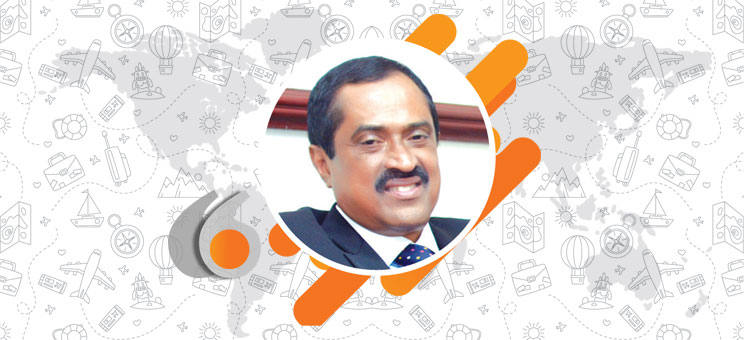Mumbai: Finance Minister Nirmala Sitharaman’s maiden Budget has evoked mixed responses from various stakeholders in the travel and tourism industry. The outlay for tourism ministriy saw marginal increase of 1.82 per cent in the budget. Rs. 1378.53 crore has been allocated for building tourism infrastructure, while Rs. 575.50 crore has been allocated for promotion and publicity. “The government is developing 17 Iconic Tourism Sites into world-class tourist destinations and to serve as a model for other tourism sites. The Iconic Tourism Sites would enhance visitor experience which would lead to increased visits of both domestic and international tourists at these destinations,” the Minister said in her maiden Budget speech. While the funds for the Tourism Ministry was Rs. 2150 crore in the 2018-2019 Budget, it rose to Rs. 2189.22 crore in 2019-2020. The announcement of developing 17 iconic world-class structures and the plan to make India an aviation manufacturing hub have been highly appreciated. However, the industry is of the view that the demand for downward revision in GST rates, definitive steps on the Input Tax Credit, boosting travel-related foreign exchange earnings and long-pending demand of Infrastructure Status for hospitality industry continue to be ignored. Destination Reporter presents the reactions from various stakeholders in the travel and tourism community.
Gurbaxish Singh Kohli
VP, FHRAI and President, Hotel & Restaurant Association of Western India (HRAWI)

The industry expectations were high but the Union Budget has neglected us completely and we are disappointed yet again. While the government wants to give impetus to hospitality and tourism and our Prime Minister has envisioned big things for the sector, there is no mention except for the 17 tourist-friendly spots which we welcome but will need further details before commenting on it until we know exactly what those spots are. We were expecting reforms in rate slabs of GST, Input Tax Credit and a definitive step to boost the domestic and inbound traffic. Hospitality plays a vital role in the growth of the economy and therefore, this sector cannot be ignored. It is one of the biggest contributors to GDP, taxes, foreign exchange and most importantly in generating employment. As per industry reports, total contribution by travel and tourism sector to India’s GDP is expected to increase from Rs. 15.24 trillion ($234.03 billion) in 2017 to Rs. 32.05 trillion ($492.21 billion) in 2028. The success of Incredible India lies in managing its hospitality and tourism correctly and it requires policy support. For the programme to be successful, it is paramount that the notion about the hospitality industry being “elitist” be dropped. Overall, this is a good budget for the middle and lower classes which will help strengthen their income base but there is nothing for the industry.
E M Najeeb
Sr. Vice President, IATO and MD, Airtravel Enterprises India Ltd.

Tourism and hospitality industry had various points in the wish-list for inclusion in the Union Budget 2019. The industry has been demanding a rationalized single GST rate for Hotel and Tourism sectors. The industry also expected higher allocation for Tourism and a declaration of Infrastructure Status for hotel sector. Now there are three layers of GST rates for hotels, of which the rate for the 4 & 5-star hotels are much higher, and they are losing out to the 3-star hotels. Moreover, because of high GST, the destinations are getting more expensive. A single rationalized rate is the need of the Hospitality and Tourism sectors. Rationalisation of GST rates for hospitality and tourism would have boosted domestic and inbound tourism and generated multifold employment. Similarly, if the Hospitality Industry is given Infrastructure Status it would reduce the cost of funds for investors. But these support measures were not included in the budget. Though the industry is a foreign exchange earner contributing largely to the GDP of the country, the demands of the industry were not considered. The liberalisation of FDI will attract more investments in the tourism, hospitality and aviation industry. The initiative to promote 17 destinations as Iconic Tourism Sites is appreciable.
Anil Parashar
President & CEO, InterGlobe Technology Quotient

Union Budget 2019 definitely marks the beginning of a new India. It will give a much-needed boost to the Indian travel and tourism sector. With the ongoing UDAN scheme for common man, we can expect better air connectivity, improved infrastructure and bridging of the gap between rural and urban sectors. Another visionary project is ‘Sagarmala’ which will enhance waterways and port connectivity that will uplift cruise tourism in India. As the government understands the need to invest and improve infrastructure, I am sure this budget will add pace to the economic development of the nation.
Aditya Ghosh
CEO, India & South Asia, OYO Hotels & Homes

The budget breaks away from tradition and nudges the public and policymakers to think outside the brown briefcase. It sets a vision for the next decade for India with an intent to bridge the socio-economic and urban-rural divide. The boost to infrastructure, labour reforms, access to capital and talent for startups and MSMEs alike will drive productivity and consumption, which is also good news for the hospitality, travel and tourism industry. The real test of this vision, however, will lie in its realisation, which is essential to deliver on the government’s promise of providing ease of living and ease of doing business. This will be possible only through concerted efforts from all stakeholders.
Sunil Bhaskaran
MD & CEO, AirAsia India

The government’s proposal to introduce aircraft financing and leasing will bring down the costs for carriers hopefully. Also, the announcement of identifying and developing 17 iconic tourism sites will boost domestic air travel demand.
Ankush Nijhawan
Co-founder, TBO Group

The budget is neutral, nothing exciting for the 5travel industry. No path-breaking initiatives nor that will impact travel negatively. Some pro-middle class measures in the budget I hope will result in more disposable incomes and hence, augur well for travel industry as a whole.
Madhavan Menon
Chairman & MD, Thomas Cook (India)

The travel and tourism industry is a crucial contributor to India’s GDP with a powerful multiplier impact, including employment generation and hence, we appreciate that the Union Budget 2019-20 lays down a clear growth priority for NDA 2.0, with potential to catalyse India’s domestic, inbound and MICE segments. Steering away from a populist approach, the government has taken a long-term view with focus on revitalising the Indian aviation and travel and tourism sector. With this budget, the government has addressed the fundamental challenges like liquidity, FDI, employment and infrastructure development. It has also focused on enhancing the role of AI, robotics, technology which will lead the nation on the path to be future-ready and to benefit employees and workforce, at large. The lowering of corporate tax (25 per cent) for companies having a turnover of up to Rs. 400 crore is a welcome move especially to MSMEs and social enterprises. The effort is clearly on environmentally responsible growth, thereby living up to our promise of sustainable development. Transportation infrastructure forms a critical base of the travel and tourism sector. And hence, the budget announcements that focus on road and waterways through Bharatmala, Jalmala and Sagarmala schemes and equally on massive railway modernisation and safety initiatives, backed by an overall budgetary outlay of Rs. 100 lakh crore, is truly a welcome move. In addition, the government’s continued focus on UDAN to boost regional air connectivity and access, while simultaneously ensuring affordability to common man, is indeed laudable. From an aviation perspective, much anticipated support to the sector has seen delivery via the Finance Minister’s announcements on FDI, aircraft financing and leasing, policy interventions for development of maintenance, repair and overhaul in India (MRO) to resuscitate the industry, and will certainly bring in a multiplier effect on airfares and job creation.
Deep Kalra
Founder & Group CEO, MakeMyTrip

Given the agrarian crisis in the country, this budget appears to have been more focused on rural India and the poor. From the travel and tourism point of view, we are pleased about the Rs. 100-trillion investment on infrastructure over the next five years. It is critical that we build better connectivity to key tourist destinations – a sore point for one of the fastest growing industry in India. There was no specific mention of fund allocation for UDAN, the regional connectivity scheme, which is disappointing. The domestic travel industry has seen some headwinds over the last few months and needs a boost. While the single quarterly GST for those with revenue less than Rs. 5 crore is a welcome move, further simplification of the GST, including centralised registrations under GST laws to bring compliance burden down for the e-commerce and services sector is required. The tax rate on premium hotels also remains staggeringly high compared to popular international destinations like Thailand, Indonesia and Sri Lanka, rendering Indian travel and hospitality industry uncompetitive. For startup and entrepreneurial ecosystem, too, there weren’t many substantive announcements barring the proposed easing of angel tax.
Varun Chadha
CEO, TIRUN Travel Marketing (Royal Caribbean International)

We are glad that the government has focused on the travel and tourism sector in this year’s budget and proposed positive steps to enhance the sector’s prospects. The government has pledged to develop 17 iconic world-class tourist sites while simultaneously popularising the existing tourist spots. India is one of the few countries that offers a dynamic tourism landscape including natural, cultural, spiritual and experiential tourism. On the domestic tourism front, the National Common Mobility Card will add to the convenience of travellers significantly for making cross-segment payments. Hopefully, the government’s initiative will help establish India as a global tourism hub and the sector to contribute much more than the 9 per cent it is to the GDP currently.
Balu Ramachandran
Sr. Vice President, Cleartrip

The Union budget has made the aviation sector more conducive for increased FDI by proposing to increase the FDI caps. This will attract increased interest in the Indian aviation space by enabling controlling stake for foreign carries and should add increased momentum to the Air India privatisation process. The success of the AI privatisation process is crucial to the health of the Indian aviation space as we can’t afford another airline bankruptcy after the Jet Airways event.
Sunil Kumar R
President, Travel Agents Association of India (TAAI)

Unfortunately, once again the budget does not focus enough on travel and tourism. Our government is not able to comprehend its value and importance. They have only remarked on Air India’s disinvestment and not on newer measures to help tourism grow. The focus given to improve tourism in India is very limited. No ‘out-of-the-box’ thinking seems to have impacted their plans. As an industry, we need to gear up with a louder voice to reinforce importance of our industry. The complications GST has created in our industry have also been ignored. It is more ‘Chalta Hai, Chalne Do’ approach that our industry receives year after year.
Jaideep Ghosh
Partner & National Head – Transport, Leisure & Sports, KPMG in India

Travel & Tourism contributes nearly 10 per cent of our GDP. Union Budget 2019 continues to encourage promoting heritage attractions, and proposes a digital repository for tribal and rural tourism attractions. These measures along with the proposed massive transport and social infrastructure development backed by digital platforms and financial sector reforms will further boost tourism.
Aashish Gupta
Consulting CEO, FAITH (Federation of Associations of Indian Tourism and Hospitality)

The intent to pump Rs. 100 lakh crore into infrastructure over the next five years, the relaxation of FDI norms in aviation, the resurgence of inland waterways, creation of the regional airports grid and highways, privatisation of railway infrastructure and of Air India will certainly create long-term conditions for growth of domestic tourism. Barring fuel surcharge on petrol and diesel, which will have a negative impact on household savings and road travel, the budget is largely positive stimulating macro economic conditions. The pain points directly impacting the Indian tourism, travel and hospitality industry remain unaddressed and even unmentioned. The lack of Infrastructure Status to hospitality and conventions which increases their funding costs, the non-availability of Export Status for our foreign exchange earning members, the non-recognition of the fact that the Indian adventure and the Indian tourism heritage industry can itself create a huge wealth of opportunities, lack of focus on creating new destinations which can take the load off the existing overcrowded ones, the levy of GST of 28 per cent which is making us globally uncompetitive, the non-availability of credits for F&B and tourist transportation, the non-parity and uncompetitive levy of GST on forex earnings in tourism , the non-availability of IGST to hospitality which is breaking the tourism-GST chain, the GST levy on outbound travel and the lack of a pre-emptive tax of 1.8 per cent for tour operators – all of these stay as points unaddressed. More so when we have a GST disadvantage of almost 15 per cent compared to our East Asian neighbours. India’s share is 1 per cent of the Foreign Tourist Arrivals, but the share of China is estimated at 4.5 per cent, Hong Kong 2 per cent, Malaysia 2 per cent and even the city state of Singapore is estimated at 1 per cent.
Sharat Dhall
COO (B2C), Yatra.com

This year’s budget aims to drive robust growth for the travel and tourism industry with the government committing to strengthening infrastructure and improving accessibility. Excited by the government’s plan to enhance 17 iconic tourism sites into world-class tourist destinations, we expect India to gain a prominent spot on the global tourism map, thus continuing the growth momentum that the industry has been enjoying so far.
Rakshit Desai
Managing Director, FCM Travel Solutions (Indian Subsidiary of Flight Centre Travel Group)

The budget has quite a few takeaways for the tourism industry. The government’s continuous commitment towards building a better physical and social infrastructure is a commendable gesture. Several initiatives which the government had undertaken like the Pradhan Mantri Gram Sadak Yojana, Bharatmala and Sagarmala projects, Jal Marg Vikas, industrial corridors and dedicated freight corridors are laudable and reflect how these infrastructural reforms will impact the tourism industry positively in the coming years. The UDAN Scheme which is designed to enable air connectivity to smaller cities is going to make air travel more accessible. The Rs. 70,000-crore capital credit infusion for PSU banks should facilitate the growth of consumer credit and accelerate consumption of travel experiences. Also, the decision to develop 17 iconic tourism sites into world-class tourist destinations will further help boost tourism in those regions and at the same time serve as a model for other tourism sites in the country. The launch of railway station modernisation programme this year will also attract more travellers and enhance railway travel experience. Crude oil prices have relaxed, however, the cost of Aviation Turbine Fuel (ATF) remains a concern as ATF constitutes around 35 per cent of the total operating costs of an airline in India, while globally it stands at about 25 per cent.
Nalini Gupta
Managing Director, Lotus Destinations (GSA: Costa Cruises India)

Indian coastline has immense potential for cruise tourism. The proposed inland waterways development by the government is a positive step towards boosting coastal tourism in India. The Varanasi-Haldia route will be an opportunity for river cruises to provide inland waterways tourism to domestic and foreign tourists. Additionally, the Government’s plan to enhance 17 iconic tourism sites into world-class tourist destinations will not only increase inbound foreign tourists and domestic tourism but will also boost related infrastructural development. The proposal of an ATM-like, ‘One Nation One Card’ for pan-India travel will ease inbound travel and be convenient for tourists to explore India without any hassles. We look forward to leveraging these opportunities for the upcoming season.









